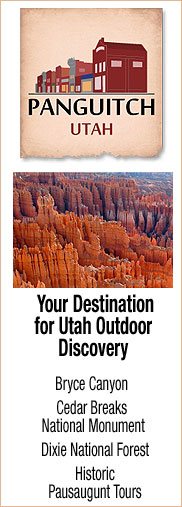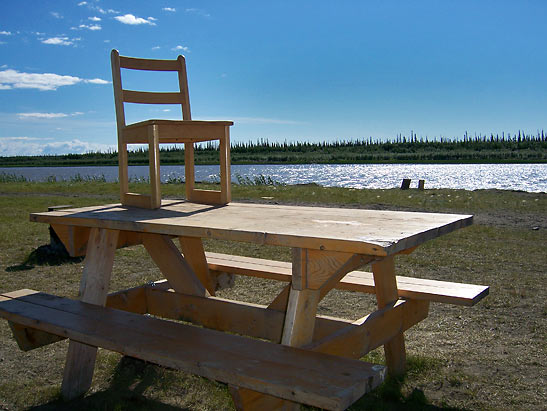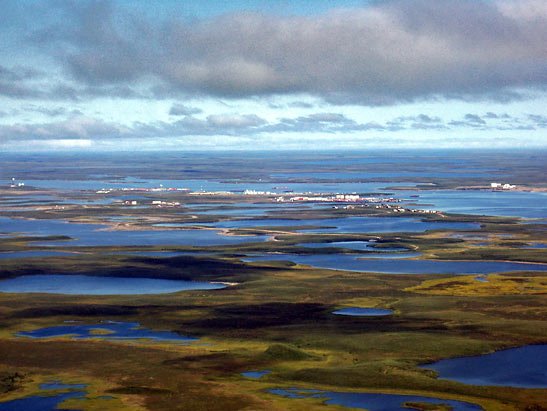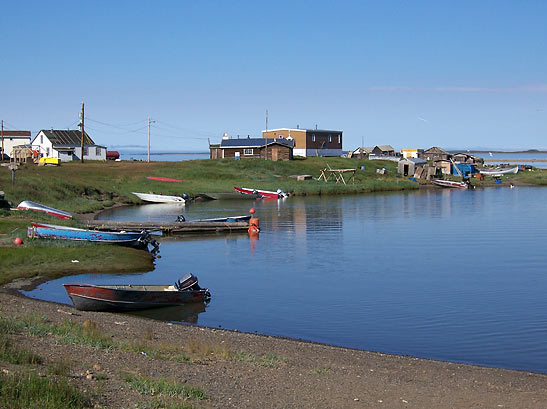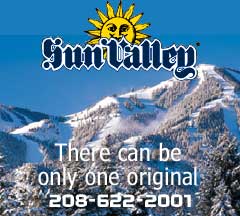 |
 |
|
 |

|
37 Above 60, Part
III
Story and photographs by Adam Sholder Wednesday, August 2nd
At 9:30 I checked in next door about my flight, but the weather had only worsened. The woman, distracted by her three small children who ran amok around the office, said I should try back again in another hour. So I returned once again to the visitor center, where I asked Jodie to give me a tour of the interpretive displays. She told me that her great-great grandfather was, in fact, one of the members of the Lost Party. The same Lost Party that was found in an unfortunately frozen state by Sergeant Jack Dempster himself. She went on to tell of how her family just got back from a whale hunt, with a successful catch of a Beluga. The native people of the region rely heavily upon the land, and whale meat is no exception. Her father, her brothers, her sister – they all had boats and they all hunted. The whale blubber is boiled in great vats to create what’s known as Muktuk. She promised to bring me some to sample the next day – if it was ready. I checked back an hour later on my flight, with no good news. No one was flying in this weather. I would have to try again tomorrow. I was a bit disappointed, but I also reminded myself that things have a way of coming together just as they should, whether we can see it at first or not. I wandered the town for a while, peeking into this building and that, filming the odd corners of this unique town. I soon found myself at the Happy Valley Campground, situated on the banks of the river just outside downtown. I chatted with the attendant, seeing if she knew of a place where I could rent a canoe or other boat, or if she knew how I could get to Tuk. She happily began making calls on my behalf, but it quickly became apparent that things happen according to no plan or schedule up in this part of the world. Phone numbers were no longer in service. Town maps were inaccurate. People came and went. Despite their enthusiastic willingness to help, people simply didn’t know what or when or where or who or how. I thanked her for her efforts, and was in my car about to move on, when she came running out, arms waving above her head. “I think these people want to talk to you, ay?” These people were Peter and Irene Bowal. They and their five children were camping at the park, and had overheard my attempts to get to Tuk. They too were looking for a plane to take all seven of them. We decided that, with my inclusion, we should be able to charter someone to get us there. Peter, a law professor at the University of Calgary, wearing a large floppy hat and a mosquito-netting jacket, was immediately on the pay phone trying to work it out. Warm and soft-spoken, he was talking with Roger up in Tuk, reviewing our options, while I chatted with Irene. Things went back and forth for a while until it looked as if we may all be able to get on a plane at 6:00 that evening, but would need to stay in Tuk at least overnight, and maybe until Friday morning. This was acceptable by all of us, but the weather was still a factor. Roger, the voice on the other end of the phone, was going to work on it, and also try to find someone with a boat. Meanwhile, Peter and I agreed to meet in an hour to ring Roger back for a status update. I ran into town for lunch, and enjoyed a musk-ox burger for lunch with a side of poutine, and was back at the payphone an hour later. Peter and I both spoke with Roger, who had a deep, warm, and wise voice, but things weren’t looking good. Only a few planes were flying, and those few seats were filled with locals. I would have to try tomorrow. I thanked Peter for his time and effort, we exchanged business cards, and we wished each other luck on our adventures. I continued exploring the town, including a stop in the community greenhouse where I met a woman from Finland. She would spend a few months every year in Inuvik, doing research on a proposed gas pipeline through the region. While in town, she kept a small plot at the greenhouse, growing carrots and tomatoes and the like. We chatted for a while, before I wandered back across town and stepped into the Igloo Church. I showed up just in time for a short docent-led tour, and, as I entered the chapel, I found myself face-to-face with my brand-new Canadian friends, the Bowals, who enthusiastically greeted me as if we were all old chums. They and their brood were there for the tour, which we all enjoyed together as the docent informed us of it’s interesting history. After the tour I went on to stroll through the enormous family center, which housed many meeting rooms, game rooms, and an Ice Hockey rink, as I attempted to find the Gwich’in feast. Again, no one I met knew exactly where or when it was happening. I continued on like this for some time, wandering the town, talking with the locals, talking with the few tourists, and just exploring the area. I came across a small grassy area near the river, strewn with a few picnic tables and scavenging Ravens. Sitting atop one of the picnic tables at an odd angle was a wooden chair. I took the chair down to the shores of the river and found a spot to sit. Two dogs briefly joined me, splashing around in the water. Their owner and her friend stopped to chat a while as they passed by my way. I sat for a few hours, contemplating all that one contemplates when sitting alone in nature by a river. I imagined this land in the winter, covered completely by a blanket of pure white. The McKenzie River, when frozen solid in late December, becomes an ice road upon which one can drive all the way to Tuk. I imagined the Northern Lights dancing their multi-colored way across the ever-darkened sky. I considered coming back here in the winter to witness all of this first hand. I also considered my options for getting to Tuk, realizing that I may not get there the next day either. John Steinbeck said, “A journey is like marriage. The certain way to be wrong is to think you control it.” I decided as I sat there on that shore, that if I couldn’t get to the Arctic Ocean the next day, then I would have to delay my return trip home until I could get there. I simply couldn’t come this far and not make it the last few miles to the Ocean. As the day drew to a close, I ended up at the Peppermill restaurant in the Finto Lodge, where I sampled some local Arctic Char. I reflected on how sometimes staying away from the popular vacation spots and tourist traps, and simply finding a unique place in the world and getting to know the locals is where one can really find the true value of travel. Today was truly an example of that. It was a great way to spend my 37th birthday.
Tuktoyaktuk Despite another foggy morning, the next afternoon I found myself in the one-room airport in Inuvik, waiting to board the single-prop, six-passenger Cessna 205. Our pilot, Simon, who couldn’t have been more than 20 years old, came out of the back room and collected us for the 40-minute flight. I boarded along with a few fellow travelers, including Andrew and his Belgium-born wife Marie-Anche, who reside in Victoria, British Columbia, as well as Jean-Pierre and his wife, visiting from France. We taxied down the dirt runway and we were off, finally, towards the Arctic Ocean. We climbed to 2500 feet, and from this vantage point the true scope of the terrain became apparent. No trees, no mountains, no sign of humankind for as far as the eye could see, which was quite far in this flat landscape. Nothing but tundra and what must have been ten thousand lakes of every shape and size in all directions. As we flew further Northwest, following the delta, the green patches of tundra began to shrink, while the blue glacial lakes grew bigger, until, at last, sitting on a relatively small scrap of tundra, was the native fishing village of Tuktoyaktuk, with the Arctic Ocean spreading out beyond it to the horizon. We landed on the precarious gravel runway – I had finally made it.
Once inside the small, pre-fab building that served as the airport, Roger, the voice on the phone from the previous day, greeted me. He was a large native man, who perfectly matched his deep, dulcet voice. “Welcome to Tuktoyaktuk, Adam.” How he knew it was me stepping off of that plane I was never quite sure. I was also warmly greeted by, yet again, Peter Bowal and his wife Irene and their pack of five, who made it in on a flight just before me. They would be staying until Saturday, borrowing Roger’s truck to get around, and his trailer to sleep. Roger escorted us by van to various sites in his town, and discussed life this far north. This was a true fishing village, with tumbledown wooden smokehouses lining the small harbor. 500 Inuit and Gwich’in call this place home, year round, and while the modern world has managed to make its way all the way up here, they still live very much a traditional life.
The highlight of the trip was making it to the shores of the Beaufort Sea on the Arctic Ocean. Despite the warning of cold, 40-degree water, it seemed much warmer as we walked across painful rocks and entered the sea. I stood there for a long time, water lapping at my legs, bending my mind around where I was and what I was doing. Not the usual Thursday. Later, while inside the village’s small church, I asked Roger how his people could manage to walk great distances over the spongy tundra in pursuit of elk or caribou. He placed his large hand on my shoulder and leaned in close, as if he was about to whisper some magical ancient Native American wisdom. He looked me dead in the eye and simply said, “Very carefully.” A few hours later we were back on the plane. This time I sat in the front, in the co-pilot’s seat. Simon the Pilot told us that we would fly out over the Ocean, then pick up the river and follow it all the way back to Inuvik. We sped down the landing strip and were off over the Arctic waters. A few minutes into the flight, Simon leaned over to me and asked, “You wanna fly the plane, ay?” Without hesitation I grabbed the yoke. I must admit that my father is a private pilot, and I have some experience flying small planes. However, our pre-pubescent pilot was not privy to this information when he asked me to take control. I thought maybe it was his nappy-time and he had to go sleepy-bye. Whatever his reasons for deputizing me a bush pilot, he pointed off in the distance and said, “Head for that lake.” With a thousand lakes in all directions I had no idea to which one he was pointing. “Which lake?” I asked. “That one, ay.” Still, no clue. I banked the plane in the general direction in which he was pointing until at last I saw the river. He told me to follow the river all the way back, which I did. So there I was, flying this Cessna 205, at 150 mph, 1500 feet over the wild Arctic Tundra. Was this really happening? I wondered if the four passengers in the back could see that their fate was now in my hands. I flew from Tuk all the way back to Inuvik. I swear this child-pilot would have let me land the bird if I hadn’t insisted on handing the controls back over to him so I could get some footage of Inuvik from the sky. We touched down safely, if not a bit roughly, at the Inuvik airport (my co-pilot admitted it may have been a smoother landing if I had stayed with the controls). I headed back to the Finto Lodge for my last dinner in town. Just as I sat at my table in this small restaurant that doubled as the hotel’s lounge, Andrew and Marie-Anche, my fellow flight passengers, walked in and I suggested we all dine together. Over dinner, I learned that they work as consultants, modeling various trends on vast areas of land in Western Canada. He had recently completed work trying to determine if the Spruce Beetle infestation of Eastern British Columbia would migrate to the west. He told me that it definitively turns out the little pests may, or may not migrate west. Okay then. We talked about ecology and the environment and politics as we enjoyed our dinner and the local beer. I learned that Canada has allowed the native peoples of the vast territorial regions of the country to not only continue to live on the same land as their ancestors have for millennia, but to also co-govern these territories. As recently as 10 years ago, the Canadian government split the Northwest Territory in two, giving half back to the Inuvaluiat people, an area now known as Nunuvat. The indigenous people continue to live a traditional lifestyle in harmony with other Canadians of the region, as well as owning cooperative businesses such as supermarkets, banks, and airlines. After dinner I made my way back to camp, where I stayed up as late as I could, watching the midnight sun work it’s way slowly across the sky, illuminating this hauntingly beautiful delta at the top of the world. Back to Whitehorse I spent the next morning at the deserted campsite, enjoying the peace and quiet and scenery, and slowly packing up my gear for the flight back to Whitehorse. I donated some items that I would no longer need to the camp attendant, trying to lighten my load. This included my red and white Canadian cooler, purchased only a week ago, some D-cell batteries, my can of Gunk tire repair, and a few bottles of Gatorade. By noon I was again at the airport and ready to board my plane for the 2½-hour trip, via a short stop in Dawson. The airport provides no security whatsoever – no metal detectors, x-ray machines, or security guards. You can keep your mukluks on, and you don’t have to take your laptop out of your sled-bag. There is, however, a large, stuffed Polar bear in the middle of the small waiting area – an intimidating deterrent to all would-be Arctic terrorists. As we exited the terminal to board, an elderly native man stepped in front of me. The attendant asked for his boarding card, but he simply shook his hand at her and grunted. She allowed him to pass without further question, and this brazen stowaway boarded the plane directly in front me. Although the gleaming silver 34-seat twin prop airplane looked sturdy from the outside, the inside was another story. Duct tape held together cracked walls. There were burn marks, chips and gouges, missing screws and buttons, ripped-up carpet – decor you generally DON’T like to see inside an airplane. I wondered if the maintenance of the inside of the plane in any way reflected the maintenance of the far more crucial outside of the plane. A few people didn’t bother to fasten their seatbelts, and a child played in the aisle. The plane sounded more like a Warner Bros. cartoon character than something supposed to be dependably airworthy. And, it was if Mel Blanc himself voiced the starting of the engine of this airship. It sputtered and choked and coughed and spat and wheezed and buzzed and sounded like Sylvester the Cat having a grand mal. Once airborne it was a surprisingly smooth flight. I caught glimpses of the Dempster Highway and even a look at the Peel River ferry and Fort McPherson as we headed for Dawson. Ninety minutes later we touched down in a disturbingly narrow canyon. We all had to disembark while they refueled the plane. Ten minutes later the flight attendant announced, “If you’re going to Whitehorse, follow me.” We followed her back on the plane, picking up a few more people for the ride. This takeoff was a bit rough, as evidenced by the young girl behind me who filled not one, not two, but three barf bags. I donated mine, and my bottle of water to the cause, as her grandmother wiped beads of sweat from her green forehead. Things eventually smoothed out, and we flew through a blanket of cloud cover until we landed in Whitehorse an hour later, in the pouring rain. Slim, Bob, and Caribou Stew I decided to rent a car for the remainder of the wet afternoon, and after I checked into my hotel I drove around Whitehorse proper, investigating its funky little corners. I stopped at the world’s largest wooden fish ladder, and watched some Chinook Salmon dance around in the water for a bit. It finally stopped raining but it was chilly and a cold wind was blowing. I ended my day at Yukon Rib & Salmon. Soon after I was seated, Slim and Bob entered the joint. Slim, and Bob. As the place was a bit crowded and I was alone at a table for four, I offered to share the table. Slim, an older gentleman, had grown up in the Territories, and worked the McKenzie River in Yellowknife as a young man (where you can still “work” a river). Now he spends his time flying his plane with his son. His pal Bob, as it turns out, was the president of Norcon, the company from which I rented the SUV for the trip. I thanked him for the excellent customer service, and sung the praises of the vehicle that served as my home for the last week. For my final sampling of Northern cuisine I enjoyed Caribou stew with bannock bread, and another few bottles of Arctic Red. After dinner I walked over to the 20-hour store behind my hotel and purchased a fine Cuban cigar. As I was fighting the wind to light my smoke with a match, a small Rastafarian man appeared out of the mist and produced a gold lighter. As he held the lighter in place while I lit my cigar he said, “A tourist sees what he expects to see, but a traveler sees what he sees.” I thanked him for the light and he assured me, “No fuckin’ problem, ay.” As I walked away I questioned the experience for a brief moment, getting a little mystical, wondering if this little Arctic Rasta had been watching over me the whole time. I turned around to catch another glimpse of him, but he was gone. I enjoyed my cigar while strolling through the brisk streets of Whitehorse. It was the darkest evening I had experienced in a week. After the Summer Solstice, the region plummets headfirst towards its two-week autumn at the beginning of September, losing five minutes of sunlight every day. I wandered the streets enjoying a significant Cuban tobacco buzz, and reflected on my past week. I thought of the many people I had met, and the sturdy, brave, and friendly souls that inhabit the region, not just enduring the harsh conditions, but actually enjoying them. As my vacation was winding down, I was already feeling the familiar fires stir for my next adventure. It would only be a few short months before I would lose myself in the jungles of Central America. As for this night, the last on my journey, I finished my cigar as it started to rain again. The clouds darkened the sky and I could have almost called it night, except for a sliver of purple light that remained in the sky to the west. Related Articles: |

FEEDBACK FOR PATTI I enjoy your newsletters -and particularly Patti Nickell's article
about the 'Pudding Club' in the Cotswold's. An old friend of mine is taking
a holiday there this year and plans to try their Jam Roly Poly and Spotted Dick
- amongst many!
FEEDBACK FOR JULIO The way I read this article, you stayed at the "Breeze
and Waves". Do you have any pictures of the cottages, and would you recommend
to some first time visitors to Caramoan? Hi Richard, Breeze and Waves was still under construction when I stayed
there in Feb. 2010. It should be finished by now. You
can see pictures of the resort on this page. We got to stay in one of the
small cottages in the picture. I'll recommend it to budget travelers but you
might want to look at other options. We chose it because of its location right
by the beach. You can try other resorts in the Caramoan town proper (you have
to get a ride to get to the beach and the jump-off point to go island-hopping
but it's a relatively short distance). There are also two higher end resorts
located on a cove and very near the islands: Gota Village Resort (unfortunately
there is something wrong with their website right now) and its twin resort Hunongan
Cove. Caramoan is a relatively new tourism development so resorts are just now
being built. I should add that it might be good to go to Caramoan (and almost anywhere in the Philippines) during the dry season from December to May. June to November are the typhoon months and sometimes typhoons will still come during early December. Julio * * * * * Hi, I'm planning to go to Caramoan this coming May. Would you
know the number of Breeze and Waves Cottages? Thanks! Hi Ann, Breeze and Waves' phone number is 0908-2911072. Look for Freddie. Hope you have a grand time at Caramoan! Julio
FEEDBACK FOR WENDY For Nature's Playground: The South Island of New Zealand Hi Wendy, In winter, Heritage Heights Apts. now offers free shuttle service to and from Queenstown 24/7 to guests without cars. We own a 7-passenger 4-wd Toyota Highlander used specifically to taxi guests up and down the hill during winter months. We also run advance purchase winter promotions which include a 4-wd rental. If any of your readers head over this direction, I will enjoy extending Heritage Heights hospitality!! Cheers --- Ailey, Owner, Queenstown, NZ * * * * * New Zealand text and pix top drawer! Almost as good as making the trip. ( but one still wants to. . . ) Full of useful detail. Only trouble with the website: It's tough figuring out which feedback goes with which article, and the more there are, the tougher it gets! --- Ken W., Camarillo CA Thanks Ken..."álmost" is right, you really have to experience the South Island firsthand. Granted this piece is long, but still all I can think about is how much I left out! I agree abut the relevancy factor re the feedback--it can be confusing...sometimes I have a "Wait a minute...what?" moment myself. Thanks for writing, Wendy * * * * * Okay Wendy, from now on whenever you book your travel, please reserve space for me. I will carry your luggage, bring you cold drinks, massage your shoulders, and change the film in your camera (oops, I guess you don't have to do that anymore). Wonderful ideas and recommendations. Can you get to New Zealand from Boston in less than a week? --- Carl A., South Easton, MA Ha ha ha Carl, you're quite the comedian! But you'd be surprised how short that flight feels. I suspect Qantas isn't the only airline who's figured out that 3 movies, 2 full meals, lots of snacks and a complimentary travel pack (eye mask, warm socks and neck pillow) equals a quiet, well-behaved cabin. It really isn't bad. Just fly direct--pick the shortest flight w/ no lengthy layovers and you'll be fine. Re: signing on as my Super Sherpa...why not? I think you know I seldom travel in anything less than Party mode. There's just that pesky background check... Thanks for writing, Wendy For Excellence Riviera Cancun: Wendy, I truly enjoyed your info especially since we leave in a week to celebrate my 50th Birthday. Was it necessary to make reservations at the restaurants? Was there a dress code for the restaurants? What would you recommend not missing while there? Was the spa experience worth it? Did you travel away from the resort while there? Thanks, --- Kim P. Fuquay, Varina, NC Hi Kim. Sorry for the delay in responding...you had heavy competition with the holidays. Reservations at Excellence restaurants are not necessary and you will not find a wait. The dress code is basically no bathing suits and flip-flops...with a decided a mix of atmospheres. Mostly the open-air beachside spots are super casual, the rest slightly more formal. Truly, as long as you are clothed, I don't think you'd be turned away anywhere, though most people seemed to enjoy dressing up at night...I suspect more for their own pleasure than any sense of decorum. The spa experience was worth it, though my favorite part wasn't the actual massage. The precursor was a 45 min. or so rotation from sauna to a series of (kind of wild) water jets which was very different and very cool, not just for women. In its' entirety, and with the serenity of the beach/champagne/strawberries, it was memorable. We did not travel away from the hotel this trip, but the hotel is very helpful in arranging day excursions to fit your desires and you do not have to book these until you arrive. Have a great time! --- Wendy
FEEDBACK FOR NINO I enjoyed Nino's contribution, since we all read about the frightening
terrorist attack. Having travelled somewhat through India years ago, I am continually
impressed with this country and the gentle spiritual aspects of this nation.
Some day I look forward to going back. Nino has encouraged me. Thank you!
FEEDBACK FOR RUSH & CHUCK Dear Mr.s/counselors Brown and Koro, Thank you for a very informed and succinct article on motorcycle accidents and the law. It inspired me to think about getting a motorcycle, but not have an accident. But, if I do I am now well informed with the basics of what to do providing I do not perish in the accident. Any tips about that too? --- Unnamed
Dear Rush and Chuck, I wish I had read your article before our camping trip the Friday prior to President's Day. My wife and I were in a car accident on our way to a camp ground. We were "rear-ended" and the impact caused our car to crash into the car in front of us. The contents of the truck that we were riding scattered onto several lanes. It's a miracle our two dogs decided to stay inside the car. My wife and I were shaken up badly but despite the mess, I was still able to walk out of the car. I got the license plate of the driver in front of me but, to my surprise, after reviewing the little damage on his car, he then sped off. I didn't know you could do that! The driver who hit me from behind gave me his information and then he too left the scene without saying good 'bye. When the police arrived all I had to go by was the little information I had jotted down which I hope was truthful. What if it was bogus? What if I had written the plate number incorrectly? How would that affect my insurance? What if we were unconscious, who would have written down all that information? I do have one suggestion if you are injured in an accident. The police asked if my wife wanted an ambulance to bring her to the hospital but we declined the offer. I remembered when I rode an ambulance years ago that it was not a comfortable ride. I was strapped to the stretcher and there were all sorts of medical equipment dangling noisily above me. As long as you are able, it is a more relaxful ride inside a car. Besides, isn't there a fee for ambulance service? --- Dave S. of Pasadena, CA
|
This site is designed and maintained by WYNK Marketing. Send all technical issues to: support@wynkmarketing.com

|


